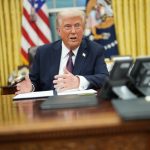From the campaign trail, President Donald Trump was consistent: He would “end the electric vehicle mandate.” So it’s no surprise the phrase popped up in an executive order he signed on Monday, just hours after being sworn into office.
Here’s the catch: The US has never had an EV mandate, or any sort of law or regulation requiring American buyers to go electric. Instead, the previous administration tried to create a series of carrots and sticks designed to make electric vehicles more appealing to both the manufacturers who make them and the people who buy them. An executive order issued yesterday attempts to undo all that.
But it’s complicated. Experts say the effects of the order aren’t clear and will likely take a while to iron out. The electric vehicle parts of the order seem more about messaging than immediate practical effects. “A lot of it is signaling the administration’s intent,” says Timothy Johnson, a professor of energy and environment at the Duke Nicholas School of the Environment. “It’s unclear what the administration will be able to do immediately.”
In the meantime, automakers will continue to make and sell electric vehicles, and consumers will continue to be able to buy them. Some stricter emissions standards kick in in late 2026, and it usually takes manufacturers some five years to plan and build a car, which means autos following those forthcoming emissions regulations should be built and sold.
US and global automakers have already backed off some of their more ambitious EV-related promises, but electrics are still coming. The long-term future of the US auto industry is far from clear. Other governments are still pursuing EV-friendly policies, and critics warn they’ll look increasingly toward China’s auto industry to get them through the transition.
One thing that is clear for the future of EVs in the United States: There will be lawsuits.
Reports IncomingMonday’s executive order demands US agencies take a look at their rules related to EVs and determine whether they’re “unduly burdensome” and interfere with consumer choice. Those agencies are supposed to write up those findings into reports, which are due in 30 days.
From there, the bureaucracy starts grinding, says Kathy Harris, who directs the clean vehicles program at the Natural Resources Defense Council. “If an agency wants to repeal a regulation, they need to go through the public process,” she says. That means publishing new proposed rules, taking public comments, going back and forth with the industry, and then publishing those comments. Lots of paperwork sits between the Trump administration and the final nixing of any EV-related programs.
The clearest way for the White House to loosen rules requiring automakers to make more EVs will be to target vehicle fuel efficiency and tailpipe standards. These require manufacturers to reach certain levels of gas efficiency across all the cars they make in the coming years and to cap the pollutants released. One of the easier ways automakers can hit those goals is to sell more electric vehicles, which don’t use gas or emit tailpipe pollutants at all. Last time Trump was in office, it took more than three years for his administration to replace Obama-era fuel efficiency standards. This time around, agencies might be more efficient and succeed in changing the rules more quickly, says Harris. Still, the process could take months and months.
Another area the Trump administration will likely target are subsidy programs, including the sort that give EV buyers federal tax credits that bring down the price of electrified cars by up to $7,500. The executive order does not explicitly mention this policy at all. This makes a sort of sense. The credits come from a law, the Inflation Reduction Act, and any changes to that law will need to make their way through Congress. The administration could try to stop handing out these credits through the Treasury Department, says Johnson, but that would likely trigger a lawsuit.
The order explicitly targets programs handing out funding for electric vehicle charging, more than $7 billion established by 2021’s Bipartisan Infrastructure Law and meant to ease the construction of new public chargers across the US. The order requires agencies to pause giving out those funds while they figure out whether they were appropriated with “consistency.” Much (but not all) of that funding has already been allocated to the states, many of which have signed contracts with infrastructure builders to get those chargers in the ground. It may be too late to put the brakes on all that charger money.
Jeff Davis, a budget and policy expert who is a senior fellow with the Eno Center for Transportation, says this section of the order is particularly “poorly drafted.” Its particular language means that it won’t prevent money from going out the door and projects getting built, but will make it hard for the states to get reimbursed after the work is done. This sort of thing “can be solved by suing the federal government and winning in court,” he says.
Another bit of wonkiness: The overly broad language of the order could mean that it not only puts a pause on climate-related programs but also all the projects funded by the infrastructure law. That includes billions in funding for highway construction projects, transit, airports, and even pipeline safety, Davis says.
The Golden StateFor those interested in the future of EVs, attention now moves to California. Since the 1970s, the state has been allowed to create its own air regulations, including rules around vehicles. The executive order set out the Trump administration’s intention to “terminate” the state’s abilities to control its own auto sales standards—exactly the power California is set to use to ban the sale of new gas-powered cars in the state by 2035.
The EPA will have to take the first step here to revoke that special privilege, granted to California through a “wavier.” That “inevitably be challenged in court,” says Julia Stein, the deputy director of the Emmett Institute on Climate Change and the Environment at UCLA’s School of Law. The last Trump administration tried to nix California’s waiver; that didn’t work. Today, attempts will likely still “stand on shaky legal footing,” says Stein. “The upshot is that we’re in for another long waiver fight.”





GIPHY App Key not set. Please check settings